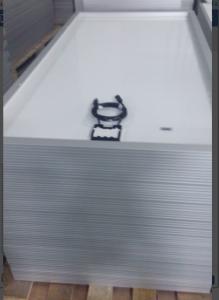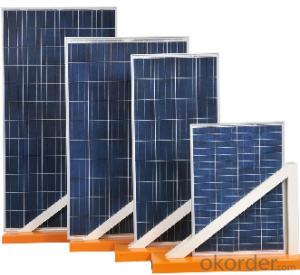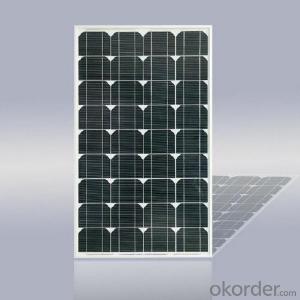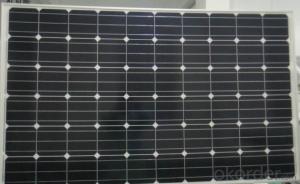Lawn Solar Panels - Solar Panel Mono, Solar Module for Best Price
- Loading Port:
- Shanghai
- Payment Terms:
- TT OR LC
- Min Order Qty:
- 2600 watt
- Supply Capability:
- 26000 watt/month
OKorder Service Pledge
OKorder Financial Service
You Might Also Like
Specification
We now provide
• Monocrystalline Solar Panel
• Polycrystalline Solar Panel( multicrystalline silicon Solar Panel)
Features of our products:
• High conversion efficiency mono/poly-crystalline amorphous silicon solar cells
• Modules incorporate high performance bypass diodes to minimize the power drop caused by shading
• High transmittance, low-iron tempered glass
• High performance EVA encapsulant to prevent destroying and water.
• AI frame: without screw, corner connection. 8 holes on the frame can be installed easily
• Good performance of preventing from atrocious weather such as wind and hails

Product Description:
CUSTOMER does not assume responsibility and expressly disclaims liability for loss, damage, or expense arising out of in anyway connected with installation, operation, use or maintenance of the PV modules. No responsibility is assumed by CUSTOMER for any infringement of patents or other rights of third parties that may result from use of PV module.
CUSTOMER reserves the right to make changes to the product, specifications or installation manual without prior notice.
Solar panel working process
In addition to being the ultimate source of all life on earth, the sun is an infinitely renewable, completely pollution-free source of electricity. Instead of burning fossil fuels dug up from the ground in a big power plant – a very 19th century, industrial age approach, when you think about it – solar panels convert sunlight directly into electricity, with no harmful emissions.
The basic unit of a solar panel is a solar cell, which usually consists of one or two layers of silicon-based semiconductor wafers. When struck by the photons in sunlight, the solar cell generates an electrical charge due to the "photovoltaic effect" – which is a pretty good name, since it produces voltage from photons. The flow of these electrons moves in a steady electrical current from one side of the cell to the other.
Dozens of these PV cells are packaged together into solar modules, which in turn are packaged into solar panels that are mounted on a rooftop and arranged to maximize their hours of exposure to direct sunlight. Because the electricity generated by all those solar cells is direct current (DC), it is then sent to an inverter that transforms the power into the same alternating current (AC) used by the appliances in your home and the local utility electricity distribution grid. Increasingly, these inverters are getting "smart," providing data monitoring for solar installation performance and other grid integration services.
FAQ
We have organized several common questions for our clients,may help you sincerely:
③Can you provide the peripheral products of the solar panels, such as the battery, controller, and inverter? If so, can you tell me how do they match each other?
Yes, we can, we have two companies for solar region, one is CNBM International, the other is CNBM engineering Co.
We can provide you not only the solar module but also the off grid solar system, we can also provide you service with on grid plant.
④What is your warranty system?
Our product performance guarantees for 25 years
• 12 years guarantee for workmanship
• Timeliness of delivery
• Quality Products certified (TÜV, UL, CE, ISO)
⑤How do you pack your products?
We have rich experience on how to pack the panels to make sure the safety on shipment when it arrives at the destination.
- Q: how much would you pay for a 2'x4' solar panel that puts out 24 volts and 74 watts?
- Build okorder /
- Q: I have a home in Manchester Tn and we have been slowly remodeling the home. It is about 200 sq ft of living space. Our normal electric bill is about 50 a month. We would like to add some solar panels to the home to help reduce the amount of the bill. How many panels do I need and what would be the cost? I am not trying to go completely of the grid but I would like to start somewhere and maybe over the years be able to add. What is your recommendation for a reasonable cost of under 2 to 3 k??
- Unless there has been some major breakthrough in solar panel efficiency - Forget it. I had looked at some utility interactive systems where the electricity generated by the solar panels went through a special inverter and into the electrical system of the house, any power you didn't use went backwards through the meter and into the grid. I figured that even if it was sunny every day, it would take about 20 years to break even on the system. That is, if I had invested $5,000 in a small system, to save $5,000 off the electric bill would take 20 years. If I had $5,000 to invest, this wouldnt be the place! It would take much more than 20 years of electrical savings to match even a modest investment. Then, don't forget what happens if 0 years from now the inverter or some of the panels fail and need replaced. Invest in fluorescent lights, maybe even LEDs. You will see a much quicker return on investment. Install more insulation, put in a heat-pump system. I appreciate you desire to save some energy, solar just isn't going to be worth doing, at least not yet.
- Q: we are doing a fundraiser to have students pledge to make donations for a solar panel instalation on one of the school buildings. I am looking for a slogan for the campain.
- Build okorder
- Q: Can solar panels be used to power a disaster relief operation?
- Yes, solar panels can be used to power a disaster relief operation. Solar panels are a viable and sustainable source of energy that can be deployed quickly in disaster-stricken areas. They can provide electricity for charging communication devices, running medical equipment, powering lighting systems, and supporting other essential operations during relief efforts. Additionally, solar panels are independent of existing power grids and can be set up in remote or inaccessible locations, making them an excellent solution for providing energy in emergency situations.
- Q: Hi, I bought 50 6X6 inch solar cells, I also bought a 40 amp diode, I still need to buy a battery, and inverter and a voltage controller, could you tell answer me the following questions:) I would like t build a small panel at first, (may be 0 X 0 inch), with that I would like (or at least to try) to power my laptop for the hole day, so I wont receive a very high amperage, yet, all the inverters I saw at e-bay are rated over 400 amp, if I buy a 400 amp inverter, can I use it with such a small amperage?2) what about buying a small car inverter, will it work?3) suggestion about the battery and the voltage controller will be kindly appreciated.Thanks
- I'm guessing that each of those solar cells is just 0.5 volt at max power, so if you make a 2-inch square panel, you will get 2 volts - not enough for the inverter. A car inverter is notoriously inefficient, but it would work if you connect it to a 2-volt battery. You cannot generally connect such an inverter to solar panels alone. The battery supplies the peak current that the inverter needs, and the panel charges the battery. To charge a 2-volt battery, you will want 36 cells, generally, which give you an 8-volt panel. You can buy an inexpensive charge controller somewhere. If your laptop will run off 2 volts directly, you can skip the inverter and be much more efficient. Or if the laptop runs of (say) 9 volts, you can use about 40 cells to get 20 volts, get the proper power plug from Radio Shack, and plug the panel directly into the laptop.
- Q: For example, how many large solar panels would you need to operate a greenhouse with lighting for simulate sun during cloudy weather, a scheduled sprinkle system and other such things?I'm looking for a very in depth answer.
- if you are talking electrical solar panels, they are rated in watts they generate in full sun. usually these panels are used in tandem with batteries, so they charge up during the day and the batteries hold a reserve of power for later use. If you figure 8 hours of useful sunlight per day, then a 40 watt panel will light a 40 watt bulb for 8 hours. you can also measure capacity in watt-hours. this would be 40x8 = 320 watt-hours. the general method is to determine how much electricity demand you have over a 24 hour period to get the total watt-hours. then divide that by the watt-hour capacity of one panel to get the number of panels needed.
- Q: Can solar panels be installed on any type of roof?
- Solar panels can be installed on most types of roofs, including flat, sloped, and metal roofs. However, the suitability of a roof for solar panel installation depends on factors such as its orientation, shading, structural integrity, and load-bearing capacity. It is recommended to consult with a solar professional to assess the specific requirements and feasibility for installing solar panels on a particular roof type.
- Q: I am doing a project for school and i need to power a 9v DC motor using a solar panel. Does anyone know places i could get these for not to expensive, and how many volts/watts i would need?
- Radio Shack.
- Q: how to use a motor with solar panel
- You really need to read up on some basic electricity before you begin this experiment. The voltages and current requirements of the motor as well as the supply all come into play
- Q: I was having a discussion with a friends about solar panels.He says that if there is a solar panel (sp) on the ground and a solar panel (sp2) high in the atmosphere (in the stratosphere) the difference in power output between sp and sp2 negligible. I said that there would be a large difference in power output because sp has all of the atmosphere to block the suns rays and sp2 has very little atmosphere because it is very high up (in the stratosphere) therefore more sun can get to the panel and more power is produced.who is correct? many thanks in advance, please leave sources if possible, for validity.
- Guide okorder /
Send your message to us
Lawn Solar Panels - Solar Panel Mono, Solar Module for Best Price
- Loading Port:
- Shanghai
- Payment Terms:
- TT OR LC
- Min Order Qty:
- 2600 watt
- Supply Capability:
- 26000 watt/month
OKorder Service Pledge
OKorder Financial Service
Similar products
Hot products
Hot Searches
Related keywords


























